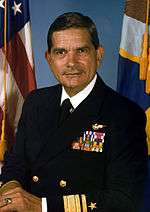Diego E. Hernández
| Diego E. Hernandez | |
|---|---|
|
Vice Admiral Diego E. Hernandez First Hispanic to be named Vice Commander, North American Aerospace Defense Command(NORAD) | |
| Born |
1930 (age 85–86) San Juan, Puerto Rico |
| Allegiance |
|
| Service/branch |
|
| Years of service | 1955-1991 |
| Rank |
Vice Admiral |
| Commands held |
USS John F. Kennedy USS Truckee Deputy Commander in Chief U.S. Space Command Vice Commander, North American Aerospace Defense Command |
| Battles/wars | Vietnam War |
| Awards |
Navy Distinguished Service Medal Silver Star Legion of Merit Purple Heart Meritorious Service Medal Air Medal |

Vice Admiral Diego E. Hernandez (born c.1930) is a retired United States Navy officer who was the first Hispanic to be named Vice Commander, North American Aerospace Defense Command (NORAD).
Early years
Hernandez (birth name: Diego Hernandez Sanfeliz[note 1]) was born and raised in San Juan, Puerto Rico, the Capital of Puerto Rico where he received his primary education. Upon his high school graduation, he was able to attend Illinois Institute of Technology with a Navy ROTC scholarship. In 1955, he earned a degree in Physics and was commissioned an Ensign in the United States Navy upon his graduation. He then underwent flight training and on August 1956, was designated a Naval Aviator.[1]
Military career
Hernandez served in carrier-based fighter squadrons at sea in a variety of assignments. He flew two combat tours in Vietnam during the Vietnam War. He also served as Aide and Flag Lieutenant to Commander, Carrier Division 14. At sea, he was the commander of Fighter Squadron 84, Carrier Air Wing Six, and a fleet oiler (the USS Truckee (AO-147)).[1]
On June 27, 1980, Captain Diego E. Hernandez relieved outgoing Captain Myers and took command of the aircraft carrier USS John F. Kennedy (CVA/CV-67). It was capable of anti-submarine warfare (ASW), making it an all-purpose carrier.[2]
On September 19, 1980, Libyan Air Force planes engaged in an unprecedented number of sorties in the vicinity of USS John F. Kennedy’s Battle Group over international waters. F-14’s under E-2 control intercepted two Libyan sections, and six and eighteen sections, respectively, on September 20 and 21.[2]
On August 29, 1981, after a change of command ceremony, Captain D. Bruce Cargill relieved Captain Hernandez as commander of the USS John F. Kennedy. In 1988, Vice Admiral Diego E. Hernandez as Commander, Third Fleet, coordinated RIMPAC '88, a massive naval exercise which included more than 40 ships, approximately 200 aircraft and more than 50,000 sailors, airmen and Marines from the United States, Japan, Australia and Canada. This exercise marked the first inclusion of a battleship, USS Missouri, as a component in RIMPAC.[3]
Vice Commander, North American Aerospace Defense Command
His last assignment on active duty was as Deputy Commander in Chief U.S. Space Command, dual hatted as Vice Commander, North American Aerospace Defense Command.[1]
In 1987, Hernandez was presented with a Lifetime Achievement Award by the National Puerto Rican Coalition. In 1988, he was named the distinguished graduate of his class by Illinois Institute of Technology and presented with the institutions Professional Achievement Award. Hernandez, retired from the Navy in 1991, after having served for a total of 36 years.[4]
Later years
Diego E. Hernandez resides in Miami, Florida. He serves as management consultant to private and public companies. In 1997 he was named to the board of directors of the Taylor Energy Company LLC. He is also a member of the Veterans Administration Advisory Committee on Minority Veterans. Hernandez is also a Companion of the Naval Order of the United States, the oldest, exclusively naval, American military society.[5]
Awards and decorations
Among Vice Admiral Diego E. Hernandez' decorations and medals were the following:
 Navy Distinguished Service Medal
Navy Distinguished Service Medal Silver Star
Silver Star Legion of Merit
Legion of Merit Distinguished Flying Cross
Distinguished Flying Cross Purple Heart
Purple Heart Meritorious Service Medal with gold star
Meritorious Service Medal with gold star Air Medal with a gold star
Air Medal with a gold star Navy and Marine Corps Commendation Medal with two gold stars and a Combat "V" device
Navy and Marine Corps Commendation Medal with two gold stars and a Combat "V" device Navy Unit Commendation with bronze star clasp
Navy Unit Commendation with bronze star clasp Navy Meritorious Unit Commendation with bronze star clasp
Navy Meritorious Unit Commendation with bronze star clasp Navy Expeditionary Medal
Navy Expeditionary Medal National Defense Service Medal
National Defense Service Medal Armed Forces Expeditionary Medal
Armed Forces Expeditionary Medal Vietnam Service Medal
Vietnam Service Medal Sea Service Deployment Ribbon
Sea Service Deployment Ribbon Republic of Vietnam Gallantry Cross Unit Citation with Palm
Republic of Vietnam Gallantry Cross Unit Citation with Palm Vietnam Campaign Medal
Vietnam Campaign Medal
Badges:
See also
- Hispanic Admirals in the United States Navy
- List of famous Puerto Ricans
- List of Puerto Rican military personnel
Notes
- ↑ This name uses Spanish naming customs: the first or paternal family name is Hernandez and the second or maternal family name is Sanfeliz.
References
Further reading
- Puertorriquenos Who Served With Guts, Glory, and Honor. Fighting to Defend a Nation Not Completely Their Own; by : Greg Boudonck; ISBN 978-1497421837
External links
- IIT Alumni
- History of USS John F. Kennedy
- USS Missouri Command History
- Hispanic Business
- Early and Pioneer Naval Aviators Association
